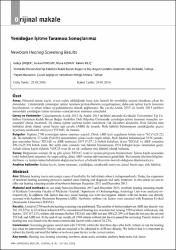| dc.contributor.author | Şimşek, Gökçe | |
| dc.contributor.author | Tursun, Serkan | |
| dc.contributor.author | Azman, Musa | |
| dc.contributor.author | Kılıç, Rahmi | |
| dc.date.accessioned | 2021-01-14T18:16:26Z | |
| dc.date.available | 2021-01-14T18:16:26Z | |
| dc.date.issued | 2016 | |
| dc.identifier.citation | Şimşek G., Tursun S., Azman M., Kılıç R. (2016). Yenidoğan İşitme Taraması Sonuçlarımız. ORTADOĞU TIP DERGİSİ, 8(3), 140 - 144. | en_US |
| dc.identifier.issn | 2548-0251 | |
| dc.identifier.uri | https://app.trdizin.gov.tr/makale/TWpNM016YzBOQT09 | |
| dc.identifier.uri | https://hdl.handle.net/20.500.12587/13180 | |
| dc.description.abstract | Amaç: Bilateral işitme kaybı, erken teşhis edildiğinde birey için önemli bir morbidite nedeni olmaktan çıkan bir durumdur. Günümüzde yenidoğan işitme taraması protokollerinin yaygınlaşması; daha çok işitme kaybı tanısının koyulmasına ve erken tedavi uygulamalarına olanak sağlamıştır. Bu yazıda Aralık 2013 ile Aralık 2015 tarihleri arasındaki yenidoğan işitme taraması sonuçlarımızı sunmayı amaçladık.Gereç ve Yöntemler: Çalışmamızda Aralık 2013 ile Aralık 2015 tarihleri arasında Kırıkkale Üniversitesi Tıp Fakültesi Hastanesi Kulak Burun Boğaz Anabilim Dalı Odyoloji Ünitesinde yenidoğan işitme taraması sonuçları retrospektif olarak incelendi. Ek olarak işitme kaybına neden olabilecek risk faktörleri araştırıldı. Risk faktörü olan bebekler direk olarak işitsel beyin sapı cevabı (ABR) ile tarandı. Risk faktörü bulunmayan yenidoğanlar geçici uyarılmış otoakustik emisyon (TEOAE) ile tarandı. Bulgular: Toplam 2700 yenidoğan işitme taraması yapıldı. Direk ABR testi uygulanan bebek sayısı 762 (%28.22) idi. Bu bebeklerin 37'sinde (%4.85) sensorinöral işitme kaybı tespit edildi. Risk faktörü bulunmayan 1938 yenidoğan arasından birinci TEOAE ve ABR testinden 1107 (%57.12) bebek kalırken, ikinci TEOAE ve ABR testinden 496 (%25.59) bebek kaldı. Bir aylık süre sonunda risk faktörü bulunmayan 1938 bebeğin hepsi taramadan geçti. Ailede işitme kaybı öyküsü, %38.23 oran ile en sık rastlanan risk faktörü olarak bulundu.Sonuç: Doğumdan sonraki ilk üç gün içinde TEOAE testi ile tarama programı başlamalıdır. İşitme kaybı açısından riskli bebeklerin anamnez ile tespit edilip, direk ABR testine tabi tutulması gereklidir. Bu konuda ailelerin bilgilendirilmesi ve testten kalan bebeklerin doğru merkezlere yönlendirilmesinin önemli olduğunu düşünmekteyiz | en_US |
| dc.description.abstract | Aim: Bilateral hearing loss is not a major cause of morbidity for individuals when it is diagnosed early. Today, the expansion of newborn hearing screening protocols enabled more hearing loss diagnosis and early treatment. In this article we aim to offer our hearing screening results of newborns between December 2013 and December 2015. Material and methods:In our study between December 2013 and December 2015, newborn hearing screening results of Kirikkale University Faculty of Medicine Hospital, Department of Otolaryngology, Audiology Unit were analyzed retrospectively. In addition, risk factors that may cause hearing loss were investigated. Infants with risk factors was directly screened with Auditory Brainstem Response (ABR). Newborns without risk factors were screened with Transient Evoked Otoacoustic Emissions (TEOAE).Results: A total of 2700 newborn hearing screening was performed. The number of babies underwent ABR test directly was 762 (28.22%). In 37 of these infants (4.85%) sensorineural hearing loss was detected. Among 1938 newborn without any risk factors, 1107 (57.12%) infants did not pass the first TEOAE and ABR test and 496 (25.29%) of them did not pass the second TEOAE and ABR test. At the end of one month, all 1938 infants without risk factors passed the screening. Family history of hearing loss was found to be the most common risk factors with a rate of 38.23%.Conclusion: Screening program should start with TEOAE within the first three days after birth. Infants at risk for hearing loss must be determined by history and are required to be subjected to ABR test directly. We believe that it is important to inform the family and send the babies who do not pass the test to the correct centers | en_US |
| dc.language.iso | tur | en_US |
| dc.rights | info:eu-repo/semantics/openAccess | en_US |
| dc.subject | Cerrahi | en_US |
| dc.title | Yenidoğan İşitme Taraması Sonuçlarımız | en_US |
| dc.title.alternative | Newborn Hearing Screening Results | en_US |
| dc.type | article | en_US |
| dc.identifier.volume | 8 | en_US |
| dc.identifier.issue | 3 | en_US |
| dc.identifier.startpage | 140 | en_US |
| dc.identifier.endpage | 144 | en_US |
| dc.relation.journal | ORTADOĞU TIP DERGİSİ | en_US |
| dc.relation.publicationcategory | Makale - Ulusal Hakemli Dergi - Kurum Öğretim Elemanı | en_US |
















